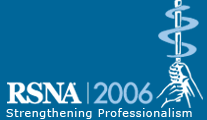
Abstract Archives of the RSNA, 2006
Chen Chaim Hoffmann MD, Presenter: Nothing to Disclose
Robert K. Fulbright MD, Abstract Co-Author: Nothing to Disclose
Eli Konen MD, Abstract Co-Author: Research grant, Koninklijke Philips Electronics NV
Joab Chapman MD, Abstract Co-Author: Nothing to Disclose
Isak Prohovnik PhD, Abstract Co-Author: Nothing to Disclose
Neuroimaging techniques have become increasingly important in the diagnosis of Jakob-Creutzfeldt disease (CJD). Our aim was to evaluate which is the most sensitive MRI technique for the detection of early changes.
As part of a large prospective clinical study six patients were diagnosed clinically and genetically as familial CJD. All patients were scanned with a protocol, which included FSE T2 FLAIR, DWI and DTI. An experienced neuroradiologist evaluated the number of involved grey matter structures- for each sequence - to determine the extent of the disease.
DTI was superior to T2 and FLAIR weighted sequences in 5/6 patients and to DWI in 4/6 patients showing a more extensive cortical involvement. The lesions in the basal ganglia were demonstrated equally with all sequences. DTI was also superior in detecting thalamic lesions in three patients while T2 and FLAIR revealed only one of them and DWI being positive in two. The control population, with the mutation but without the clinical disease, did not show the changes in the DTI sequence.
DTI plays an important role in the early diagnosis of familial CJD. Its main superiority is in the detection of cortical and thalamic lesions. Therefore it is recommended to perform DTI in all cases suspected of CJD, though considered a grey matter disease.
It is recommended to perform DTI in all cases suspected of CJD, though considered a grey matter disease.
Hoffmann, C,
Fulbright, R,
Konen, E,
Chapman, J,
Prohovnik, I,
Early Detection of Familial Jakob-Creutzfeldt Disease: Comparison of T-2, FLAIR and DTI Techniques. Radiological Society of North America 2006 Scientific Assembly and Annual Meeting, November 26 - December 1, 2006 ,Chicago IL.
http://archive.rsna.org/2006/4431798.html

